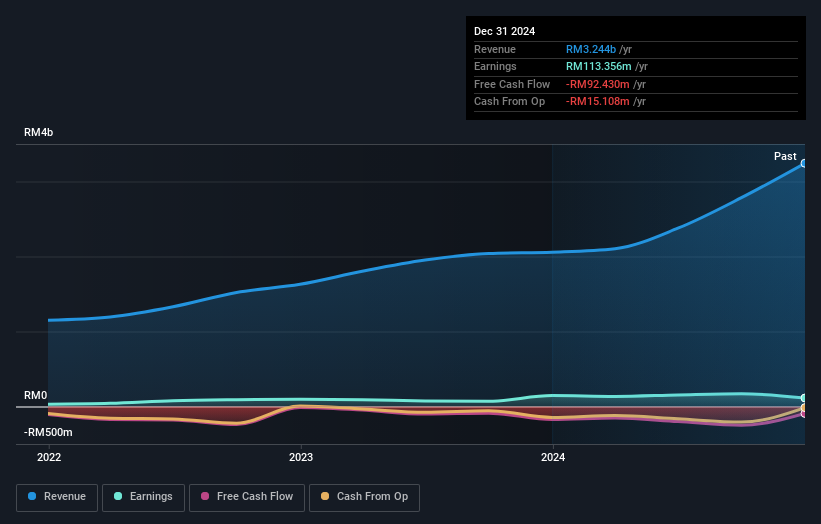Private companies are Chin Hin Group Berhad's (KLSE:CHINHIN) biggest owners and were hit after market cap dropped RM389m
Key Insights
- The considerable ownership by private companies in Chin Hin Group Berhad indicates that they collectively have a greater say in management and business strategy
- 60% of the business is held by the top 2 shareholders
- Insiders own 29% of Chin Hin Group Berhad
A look at the shareholders of Chin Hin Group Berhad (KLSE:CHINHIN) can tell us which group is most powerful. The group holding the most number of shares in the company, around 40% to be precise, is private companies. In other words, the group stands to gain the most (or lose the most) from their investment into the company.
Following a 5.1% decrease in the stock price last week, private companies suffered the most losses, but insiders who own 29% stock also took a hit.
In the chart below, we zoom in on the different ownership groups of Chin Hin Group Berhad.
Check out our latest analysis for Chin Hin Group Berhad

What Does The Institutional Ownership Tell Us About Chin Hin Group Berhad?
Institutions typically measure themselves against a benchmark when reporting to their own investors, so they often become more enthusiastic about a stock once it's included in a major index. We would expect most companies to have some institutions on the register, especially if they are growing.
Institutions have a very small stake in Chin Hin Group Berhad. That indicates that the company is on the radar of some funds, but it isn't particularly popular with professional investors at the moment. So if the company itself can improve over time, we may well see more institutional buyers in the future. It is not uncommon to see a big share price rise if multiple institutional investors are trying to buy into a stock at the same time. So check out the historic earnings trajectory, below, but keep in mind it's the future that counts most.

Hedge funds don't have many shares in Chin Hin Group Berhad. Divine Inventions Sdn. Bhd. is currently the company's largest shareholder with 37% of shares outstanding. With 23% and 5.8% of the shares outstanding respectively, Beng Teik Chiau and Haw Chiau are the second and third largest shareholders. Interestingly, the bottom two of the top three shareholders also hold the title of Top Key Executive and Member of the Board of Directors, respectively, suggesting that these insiders have a personal stake in the company.
To make our study more interesting, we found that the top 2 shareholders have a majority ownership in the company, meaning that they are powerful enough to influence the decisions of the company.
While studying institutional ownership for a company can add value to your research, it is also a good practice to research analyst recommendations to get a deeper understand of a stock's expected performance. Our information suggests that there isn't any analyst coverage of the stock, so it is probably little known.
Insider Ownership Of Chin Hin Group Berhad
The definition of company insiders can be subjective and does vary between jurisdictions. Our data reflects individual insiders, capturing board members at the very least. The company management answer to the board and the latter should represent the interests of shareholders. Notably, sometimes top-level managers are on the board themselves.
Most consider insider ownership a positive because it can indicate the board is well aligned with other shareholders. However, on some occasions too much power is concentrated within this group.
Our most recent data indicates that insiders own a reasonable proportion of Chin Hin Group Berhad. Insiders own RM2.1b worth of shares in the RM7.3b company. That's quite meaningful. Most would be pleased to see the board is investing alongside them. You may wish to access this free chart showing recent trading by insiders.
General Public Ownership
The general public-- including retail investors -- own 29% stake in the company, and hence can't easily be ignored. While this size of ownership may not be enough to sway a policy decision in their favour, they can still make a collective impact on company policies.
Private Company Ownership
It seems that Private Companies own 40%, of the Chin Hin Group Berhad stock. Private companies may be related parties. Sometimes insiders have an interest in a public company through a holding in a private company, rather than in their own capacity as an individual. While it's hard to draw any broad stroke conclusions, it is worth noting as an area for further research.
Next Steps:
While it is well worth considering the different groups that own a company, there are other factors that are even more important. Case in point: We've spotted 3 warning signs for Chin Hin Group Berhad you should be aware of, and 1 of them is significant.
Of course this may not be the best stock to buy. Therefore, you may wish to see our free collection of interesting prospects boasting favorable financials.
NB: Figures in this article are calculated using data from the last twelve months, which refer to the 12-month period ending on the last date of the month the financial statement is dated. This may not be consistent with full year annual report figures.
Have feedback on this article? Concerned about the content? Get in touch with us directly. Alternatively, email editorial-team (at) simplywallst.com.
This article by Simply Wall St is general in nature. We provide commentary based on historical data and analyst forecasts only using an unbiased methodology and our articles are not intended to be financial advice. It does not constitute a recommendation to buy or sell any stock, and does not take account of your objectives, or your financial situation. We aim to bring you long-term focused analysis driven by fundamental data. Note that our analysis may not factor in the latest price-sensitive company announcements or qualitative material. Simply Wall St has no position in any stocks mentioned.
 Wall Street Journal
Wall Street Journal